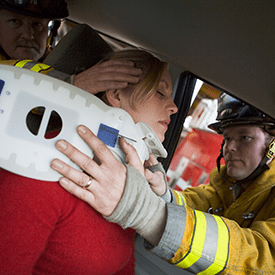$5
Million
$5 million settlement
We recently won a $5 million settlement for a wrongful death & injury case to survivor due to car crash.
Traumatic Brain Injuries from Car Accidents in Indianapolis
Traumatic brain injuries, or TBIs, can have many causes: accidents, falls, sports, and violent assaults. A little more than 50,000 people die each year in the U.S. from all causes of TBI. It is the leading cause of death and disability of those under 45. Over 1.5 percent of all U.S. residents—5.3 million people—are living with disabilities that resulted from a TBI. That’s about one in every 66 people.
A large number of TBIs arise from motor vehicle accidents, the second or third most common cause of brain injury, depending on the source of the statistics. Among those aged 5 to 24 (the data is from years 2006-2010), TBIs from auto accidents were the leading cause of death. When it came to hospitalizations for the same time span, TBIs were the leading reason for admission for those aged 15 to 44.
The percentages of those injured or killed by TBIs vary; some peg the number as high as 51 percent. One thing that is certain is that TBI is hardly rare, and the emotional and financial costs can be extreme. Just ask the Benignos of Clifton, NJ, who have been providing 24-hour care for their son for over 30 years. In 1984, he was hit by a car, suffering a severe TBI that left him unable to speak or walk.
The Varieties of Brain Injuries

TBIs can entail no external wounds (meaning closed-head trauma) or include external damage (meaning open-head trauma). Open-head or penetrating brain injuries often involve invasive, external objects such as bullets or knives, though open-head injuries can also result from skull fractures. Such TBIs are called focal injuries because they affect a very specific, or focused, area of the brain.
In contrast, closed-head TBIs are diffuse, meaning the injury often occurs throughout the brain. In a closed-head TBI, the brain impacts the inside of the skull, either damaging the entire brain or one or more specific areas. The hallmarks of closed-head TBIs are injuries arising from external forces that shake or shear the brain or result in an external head impact. When the forces are great enough, the cushioning fluid that surrounds the brain is not sufficient to prevent damage. Motor vehicle accident TBIs tend to be closed-head.
TBIs can range from mild to severe, depending on the score registered on the Glasgow Coma Scale (GCS). The GCS grades a person’s level of consciousness from 3 to 15, with 15 being the least severe. TBIs can also be classified according to the following symptoms:
- Mild TBIs, 13 to 15 on the GCS, are characterized by a brief loss of consciousness (up to a few minutes), post-traumatic amnesia (PTA) of less than one hour, and normal brain imaging results. Note that “mild” does not necessarily mean that the brain injury is of no consequence. All brain injuries are significant.
- Moderate TBIs are characterized by a loss of consciousness lasting from 1 to 24 hours, PTA of 1 to 24 hours, and abnormal brain imaging results. An 8 to 12 on the coma scale is another hallmark, along with confusion and other cognitive impairment that can last for weeks. Sometimes the person suffers permanent brain damage.
- Severe TBIs involve a GCS of less than 8, a loss of consciousness or coma for more than 24 hours, amnesia for more than 24 hours, and abnormal brain scans. Comas, various vegetative states, and Locked-In Syndrome (being aware but unable to move or speak) can all signify severe TBI.
The Kinds of TBIs Most Common to Car Accidents
While many kinds of brain injuries exist, certain types are most likely in car accidents. The forces involved in collisions often create closed-head injuries that can show little external signs of injury, though the internal damage may be quite serious. These common forms of TBI are:
- Often classified as the mildest form of TBI, concussions can be caused when the head impacts something, such as the steering wheel or the side frame of the car’s interior. Concussions can also be caused by acceleration or deceleration injuries where the brain moves suddenly inside the skull in response to external forces generated by the accident’s impact. One form of this is called whiplash. (If you are in a stationary car that is hit, you can suffer acceleration damage. If you are moving and hit something stationary, you can suffer deceleration damage.) Concussions injure the entire brain, and healing can take up to several weeks.
- Diffuse axonal injury. When the brain’s motion inside the skull trails the skull’s movement, it can cause shearing forces that tear nerve tissue inside the brain. These strong forces stretch the nerve tissues, or axons, until they tear. Diffuse axonal injury is often widespread and permanent. Such an injury can be severe, and may bring on death.
- When the head hits another object, contusion can occur. A contusion means that a specific area of the brain is bruised, and the bruise can be a coup or a contrecoup injury. A coup contusion happens on the side of the brain that sustains the impact, while a contrecoup contusion occurs on the opposite side, a result of the brain striking the skull on the inside. The risk of bleeding in the brain is always present with a contusion, though it does not always occur. Should bleeding result in a clot, or hematoma, surgery may be needed to remove it.
Outcomes and Healing from a TBI
After an accident, a TBI can give rise to changes in consciousness, mental states, and memory. Certain areas of the brain can be short-circuited, notably those responsible for thinking and reasoning, the five senses, communication and understanding, and emotions (depression, anxiety, aggression, and inappropriate behaviors). These changes can be short-term or long-term, and can cause problems not only for the injured person but also for their family and friends.
A TBI can also trigger epilepsy or increase the risk of brain disorders that become more likely as we age, such as Alzheimer’s or Parkinson’s diseases.
Repeated TBIs, even mild ones, over the years can bring about significant cognitive problems, such as those that have occurred with professional boxers and football players. Repeated TBIs, even mild ones, which happen only hours or days apart, can result in Second-Impact Syndrome. Rapid death often follows.
If you have been in an accident in which you sustained a TBI, even a mild one, it is critical that you rest and avoid activities that could expose you to the risk of a second brain injury in a short period of time. Recovering from a TBI can take much longer than you might think, so it is important to follow the instructions your health professional gives you regarding when it is safe to drive, ride a bike, and use heavy or dangerous equipment. Be sure to seek professional help should you need to relearn life skills.
About Mike Stephenson:
Mike Stephenson, a personal injury lawyer with Stephenson Rife of Shelbyville, Indiana, near Indianapolis, has been successfully litigating motor vehicle accident cases in Indiana since 1982. He can be reached at 317-680-2501.

 Brady Rife has developed a diverse civil litigation practice for plaintiffs throughout Indiana. Brady is heavily involved in serious personal injury matters, complex business and commercial disputes, and insurance litigation in state and federal courts. Brady has successfully tried several jury trials and bench trials as lead counsel and has also briefed multiple cases before the Indiana Court of Appeals. [
Brady Rife has developed a diverse civil litigation practice for plaintiffs throughout Indiana. Brady is heavily involved in serious personal injury matters, complex business and commercial disputes, and insurance litigation in state and federal courts. Brady has successfully tried several jury trials and bench trials as lead counsel and has also briefed multiple cases before the Indiana Court of Appeals. [ 


